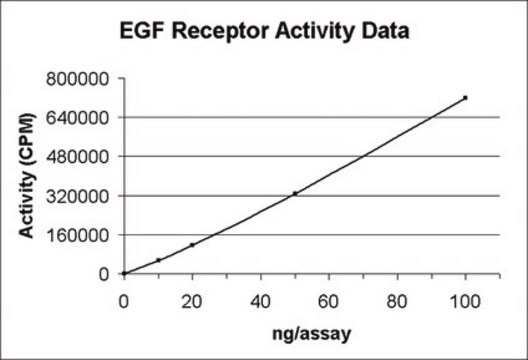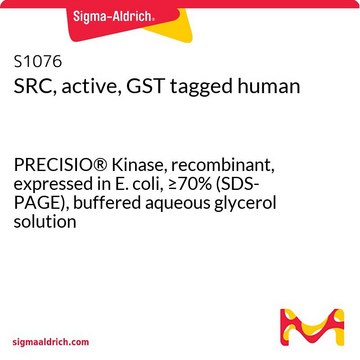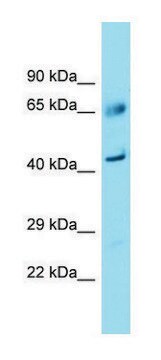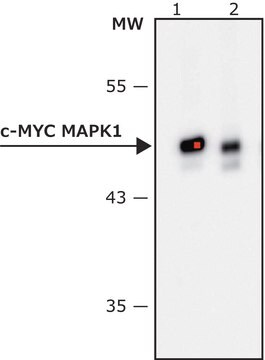14-326-M
Src Protein, active, 10 µg
Active, N-Terminal His6-tagged, recombinant, full-length, human Src. For use in Kinase Assays.
Sinónimos:
SRC1
Iniciar sesiónpara Ver la Fijación de precios por contrato y de la organización
About This Item
UNSPSC Code:
12352202
eCl@ss:
32160405
NACRES:
NA.26
Productos recomendados
biological source
human
Quality Level
recombinant
expressed in Sf21 cells
form
liquid
mol wt
Mw 61.7 kDa
manufacturer/tradename
Upstate®
technique(s)
activity assay: suitable (kinase)
solubility
soluble
NCBI accession no.
UniProt accession no.
Gene Information
human ... SRC(6714)
General description
Research area: Cell Signaling
N-Terminal His6-tagged, recombinant, full-length, human Src.
Src proteins are non-receptor protein tyrosine kinases, that belong to the Src family of kinases. These proteins have a unique structure consisting of an N-terminal region with a 14-carbon myristoyl group, two Src homology domains (SH2 and SH3), a catalytic tyrosine-protein kinase domain (SH1), and a short C-terminal tail. The SH1 domain is catalytic in function, while the SH2 and SH3 domains are non-catalytic and regulatory in nature.
Product Source: Human c-src, expressed in Sf21 cells.
N-Terminal His6-tagged, recombinant, full-length, human Src.
Src proteins are non-receptor protein tyrosine kinases, that belong to the Src family of kinases. These proteins have a unique structure consisting of an N-terminal region with a 14-carbon myristoyl group, two Src homology domains (SH2 and SH3), a catalytic tyrosine-protein kinase domain (SH1), and a short C-terminal tail. The SH1 domain is catalytic in function, while the SH2 and SH3 domains are non-catalytic and regulatory in nature.
Product Source: Human c-src, expressed in Sf21 cells.
Application
The Src protein may be used to study the interaction between CD133 and Src protein and its effect on FAK phosphorylation and cell migration through in vitro kinase assay.
Biochem/physiol Actions
Src protein tyrosine kinases are involved in signaling pathways that control a plethora of cellular functions ranging from cell cycle, proliferation, differentiation, gene transcription, immune responses, apoptosis, etc. Upon its activation, Src phosphorylates and activates several other kinases Like MAPK (Mitogen-Activated Protein Kinase), p38, and ERK (Extracellular signal-regulated kinase). Activated MAPK (Mitogen-Activated Protein Kinase) regulates inflammation, cell development, differentiation and senescence. P38 is involved with the migration and survival of endothelial cells and extracellular signal-regulated kinase (ERK) promotes the proliferation and inflammation of endothelial cells. They play a key role in the regulation of cytoskeletal organization through the phosphorylation of substrates like Actin filament-associated protein 1 (AFAP1) and cortactin (CTTN). Src also plays a crucial role in maintaining cell adhesion, morphology, motility, and bone resorption by interacting with focal adhesion kinases. Src tyrosine kinase activity is upregulated in a variety of cancers including colon, lung, and pancreatic cancer, etc.
Packaging
2 vials at 5μg each
Also available in 250μg size (2x125μg)--call for pricing and availability and reference catalog number 14-326M when ordering the 250μg size.
Also available in 250μg size (2x125μg)--call for pricing and availability and reference catalog number 14-326M when ordering the 250μg size.
Quality
Routinely evaluated by phosphorylation of Src Substrate Peptide
Other Notes
For Specific Activity data, refer to the Certificate of Analysis for individual lots of this enzyme.
Legal Information
UPSTATE is a registered trademark of Merck KGaA, Darmstadt, Germany
signalword
Warning
hcodes
Hazard Classifications
Skin Sens. 1
Storage Class
12 - Non Combustible Liquids
wgk_germany
WGK 2
flash_point_f
Not applicable
flash_point_c
Not applicable
Certificados de análisis (COA)
Busque Certificados de análisis (COA) introduciendo el número de lote del producto. Los números de lote se encuentran en la etiqueta del producto después de las palabras «Lot» o «Batch»
¿Ya tiene este producto?
Encuentre la documentación para los productos que ha comprado recientemente en la Biblioteca de documentos.
Protein tyrosine kinases, with emphasis on the Src family.
Courtneidge, S A
Seminars in Cancer Biology, 5, 239-246 (1994)
Jianhui Ma et al.
Cancer cell, 35(3), 504-518 (2019-03-05)
Ionizing radiation (IR) and chemotherapy are standard-of-care treatments for glioblastoma (GBM) patients and both result in DNA damage, however, the clinical efficacy is limited due to therapeutic resistance. We identified a mechanism of such resistance mediated by phosphorylation of PTEN
Nuestro equipo de científicos tiene experiencia en todas las áreas de investigación: Ciencias de la vida, Ciencia de los materiales, Síntesis química, Cromatografía, Analítica y muchas otras.
Póngase en contacto con el Servicio técnico









